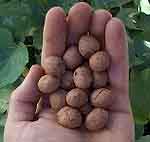Index of articles and links
Soil organisms, particularly fungi that help plant roots absorb nutrients (mycorrhizae), are vital to maintaining soil health. The organisms present affect which nutrients are available and which plants can grow and thrive. Soil life can be seeded, its activity measured, and its health promoted by good management. For an excellent series of short films on the various forms of microscopic soil life, see T. Loynachan's Soil Biology Movies at Iowa State University.
 Seed balls protect broadcast seed until the rain comes. Compost in the mix provides necessary soil life. |
Working with soil organisms
Elaine Ingham runs Soil Foodweb, a good resource for understanding the life of the soil and renewing its health. Soil Foodweb's overview of soil organism restoration process.Mycorrhizas page at the University of Edinburgh. Mycorrhizas are symbiotic relationships between fungi and plant roots. According to plant pathologist Stephen Wilhelm, "in agricultural field conditions, plants do not, strictly speaking, have roots, they have mycorrhizas."
Mycorrhiza site by Ted St. John with articles about landscape restoration using inocula.
Mycorrhizae.com has articles about forest, nursery, and turfgrass applications of mycorrhizae.
Seed balls are a mix of seeds, dry compost , and clay. The clay coat protects the seeds from hungry animals, overheating, wind, and dryness, and the compost provides soil microbes and fungi. At www.seedballs.com.
Seed ball recipe at pathtofreedom.com has step-by-step photos. Makes a small starter batch.
Promoting soil life
Improving soil health and building new soil (articles). How to use managed grazing to promote new soil formation, up to several cm per year.Revegetating soilless land (articles). Soil-building is a vital part of revegetating sites where topsoil has been lost or never existed in the first place.
Dung beetles
These beneficial insects and their allies destroy fly breeding sites, interrupt parasite life cycles, bury nutrients in the root zone, improve soil and pasture health, and greatly increase soil's ability to absorb water.
Dung beetles and their effects on soil by Pat and Dick Richardson. Dung beetles on an Oklahoma ranch increased water infiltration 129% and can bury 1 ton of wet manure per acre per day (2 metric tons/ha).
The benefits of dung beetles imported to Australia when native dung beetles ignored cattle dung. Part 1, Part 2 at ABC Online.
If encouraged, insects in cattle dung could provide benefits worth Canadian $2,000 million yearly. At Lethbridge Research Centre site.
Related articles and links